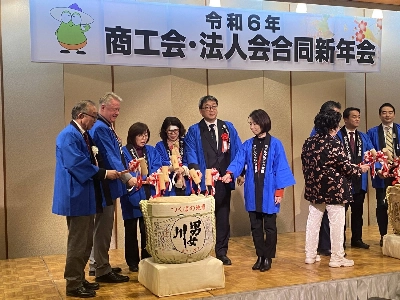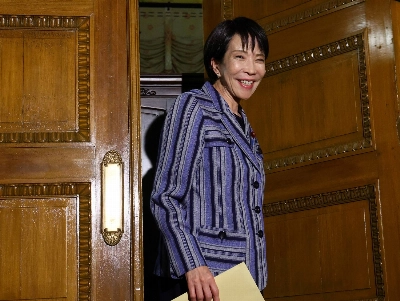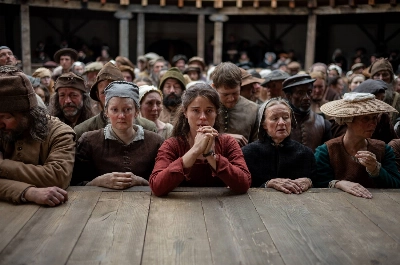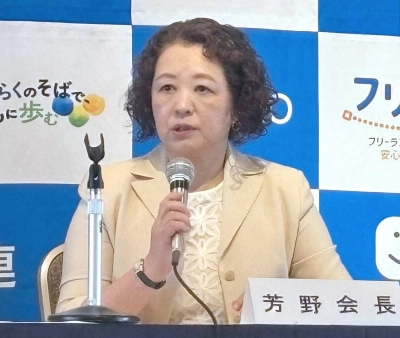A stroll around Hanae Mori's retrospective, being held until April 11 at the New National Theater in Shinjuku, is for me like wandering back down memory lane: I remember admiring the floral dresses -- peonies or wisteria -- when, in a flash of brilliant color, they burst onto the catwalk for the first time in Paris in 1998.
I also remember the swirling Chinese characters on fluid chiffon off-shoulder gowns in 2002, and the many variations over the years on her sexy bustier dresses and oh-so-elegant black velvet and lace ensembles.
And that's not to mention the trademark butterfly classics or the elegant kimono dresses that Japan's first lady of fashion has been known for the world over since her peak in the 1980s and '90s.
Long before that, though, Mori had been working hard in Tokyo to build on the fame she attracted following the success of her "East Meets West" collection in New York in 1965 -- her international debut -- and her friendship around that time with the late Princess Grace of Monaco.
As Mori's "fusion couture" reputation grew, she was for many years a fixture -- and the only Japanese -- on the Paris collections calendar. Then, in 1977, she opened her salon there and, as a member of the prestigious Chambre Syndicale de la Haute Couture, began presenting her blended vision of the Orient and Occident twice yearly on the Paris runway.
But now, as she enters her eighth decade, Tokyo's lady of impeccable taste is winding down: Her design house has been taken over by Mitsui & Co. and she no longer participates in the Paris collections. The Hanae Mori Building, her Kenzo Tange-designed glass-and-chrome edifice in Tokyo's fashionable Omotesando district, continues to host the Hanae Mori boutique, but the truth is that Madame Butterfly's wings are gently but surely enfolding.
As Suzy Menkes, respected fashion editor of the International Herald Tribune, told me in Tokyo last week, "I think Hanae Mori is part of the history of Japanese fashion. She was a designer who understood the couture spirit of the Western world, and she also had the courage and dynamism as a woman designer to create her own business."
But the fact remains that this retrospective is a treasure trove of elegance and beauty drawn from Mori's decades as a true couturiere.
Included, of course, are the classics with their butterflies and flowers, some beaded, some sequined, some painted, some embroidered -- but all handmade.
The 70-odd pieces included in the exhibition are just a few of the many thousands designed by Mori over the last half century, since she created her first atelier as a theatrical costume designer based in Tokyo's Shinjuku district.
Also on show are pieces she designed for the Noh play "Takayama Ukon" and costumes created for the opera "Elektra" and the ballet "Cendrillon." Nearby hangs a series of photographs from the latter two productions.
"I like flowers, and over the years I created many garments inspired by them," Mori told me last week, adding that she has included three floral pieces in the exhibition. "Especially, I like wisteria -- and the season of wisteria is now approaching."
Heartfelt wish
Couture, as it has done for the last century or more, lives on -- but what, I asked Mori, does she think the future of the genre is?
"Our lifestyles have changed so much," she said, "and people now buy pieces that are easy to wear. But even though times have changed dramatically, it is my wish that handmade craftsmanship will remain as a treasure."
That heartfelt wish, however, may be destined to be denied.
In fashion circles, there are always predictions that the end of haute couture is nigh, as fewer and fewer people become willing to splash out on extravagant outfits. But with Hanae Mori bowing out of the couture world, and ever fewer of her contemporaries plying their perfectionist trade, those prophecies seem more likely than ever to be coming true, as fashion's high end yields to pretenders whose creations bear labels that may be well known -- but not for their couture.
"Hanae Mori Haute Couture -- The Art of Hand Craftsmanship" is at the New National Theater (2F), Shinjuku, Tokyo, until April 11; open 10 a.m.-7 p.m.; admission 700 yen (students 500 yen). For more information, call (03) 3406-1169.
Related stories on Japan Fashion Week:
Virtual retailers forge fortunes with fashion



















With your current subscription plan you can comment on stories. However, before writing your first comment, please create a display name in the Profile section of your subscriber account page.